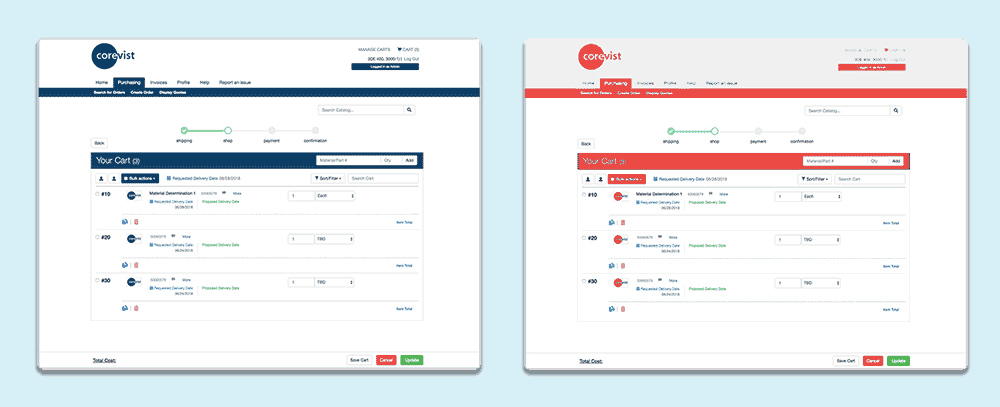Share
Author
George Anderson
Share
Multiple Storefronts with Corevist
At Corevist, our clients often come to us with plans to expand their ecommerce business. They’ve launched our SAP ecommerce platform in one market. Now they’re ready to scale that operation to new sales areas, new product lines, or both. Two questions often arise:
- Do we need additional storefronts?
- Can we reuse our Corevist Commerce integration to SAP, or does it need to be rebuilt?
Here’s the process we use to help our clients answer those questions. You can use the same process to understand the requirements you may face in launching multiple storefronts at your organization.
Question 1: Do we need additional storefronts?
For the global manufacturers we work with, the answer to this question isn’t always obvious. Here are some common criteria which indicate you need an additional storefront:
- You’re selling the same product line in a different country with different currency and/or language requirements.
- You’re launching a new product line in a new market. Your existing site’s user experience is appropriate for the existing market, but not for the new market or the new product line.
- You’re going direct to consumer. Your existing site is set up for your distributors and dealers, but their needs are nothing like your B2C consumer’s needs.
If the answer to any of these is “yes,” you most likely need an additional storefront. The good news is, in many cases, you’ll be able to “scale” your one instance of Corevist Commerce to include a new storefront. In other words, you won’t need an entirely new implementation.
However, the ability to do that depends on how templatized your SAP system is.
Question 2: Can we reuse our Corevist Commerce integration to SAP, or does it need to be rebuilt?
Scenario A: No significant differences in SAP configuration
The answer to this question leans on the word “template.” In the Corevist Commerce architecture, the template starts all the way back in SAP. If your organization has taken advantage of the fact that you have SAP, and if you’ve configured SAP well, then the various geographies and business areas shouldn’t have a lot of differences between them, other than language, currency, and maybe the particular products sold. But business processes, the workflows for order fulfillment, all these things should be fairly the same.
In that case, you don’t have to rebuild another instance of Corevist Commerce to support each new web store.
If you’re starting with an SAP configuration that’s built on the same template across multiple business areas, then you can reuse your Corevist Commerce integration to SAP in launching your new storefronts. In that case, our architecture just slips right in. Once you’ve launched your first instance of Corevist Commerce, the others just roll out.
Scenario B: Significant differences in SAP configuration
However, if the SAP configuration differs between the business areas, you may need a new Corevist Commerce implementation to support your new store. Here are some common criteria indicating you need a separate implementation:
- The distribution channel is set up differently in SAP.
- The customers have unique needs expressed in unique business rules in SAP.
- The ordering process is set up differently in SAP.
- The products in the new web store are sensitive, government-regulated, or have another constraint on their distribution.
The Takeaway: Corevist supports both
Whether your SAP configuration across business areas is templatized, or whether you have unique configuration in different business areas, Corevist supports both. In fact, we sometimes find ourselves supporting both models at the same client. 😊 For us, it comes down to knowing our client’s needs and making the best recommendation we can as a trusted advisor.
Moving forward: FREE case study
Wondering how a globalized manufacturer handles multiple brands and sales areas in ecommerce? Download this case study on Oregon Tool. You’ll learn how this leading manufacturer of forestry and agricultural equipment transformed their business through Corevist Commerce.
[want_more title=”Learn more” subtitle=”FREE Case study: Oregon Tool” description=”Learn how multiple departments came together as Oregon Tool launched ecommerce.” button_text=”Download Now” button_link=”https://www.corevist.com/blount-international-inc/” button_class=”btn btn-primary blount-case-study” title2=”See it for yourself” subtitle2=”Talk to us” description2=”Curious what Corevist Commerce can do for you? Let us show you a personalized demo. You’ll see ecommerce with real-time SAP data.” button_text2=”Schedule Demo” button_link2=”https://www.corevist.com/demo/” button_class2=”demo-popup”]









